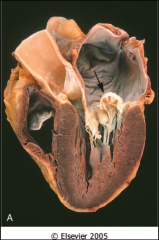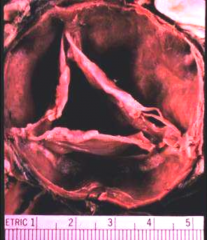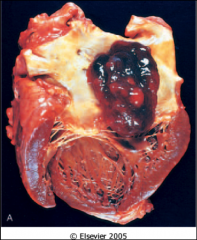![]()
![]()
![]()
Use LEFT and RIGHT arrow keys to navigate between flashcards;
Use UP and DOWN arrow keys to flip the card;
H to show hint;
A reads text to speech;
31 Cards in this Set
- Front
- Back
|
Significant disease of the valves in the ________ heart is rare and almost always congenital.
|
Right
|
|
|
The failure of a valve to open completely, leading to pressure overload.
|
stenosis
|
|
|
The failure of a valve to close completely, leading to volume overload.
|
insufficiency/regurgitation
|
|
|
Acute rheumatic heart disease affects what parts of the heart?
|
-ALL - pancarditis (acute valve disease is not usually clinically significant, chronic is manifested as valvular disease)
|
|
|
Describe the findings of valvulitis in acute RF
|
-fibrinoid necrosis in foci along the valve leaflets
-overlying these areas are small vegetations along the lines of closure of left-sided valves -called verrucous endocarditis |
|
|
Degenerated collagen surrounded by lymphocytes found in acute RF
|
Aschoff bodies
|
|
|
Activated macrophages with caterpillar-like nuclei surrounding degenerated collagen in acute RF
|
Anitschkow cells
|
|
|
Valve disease from chronic rheumatic fever typically presents at what age?
|
30-50
|
|
|
Chronic RF is the most common cause of _____________.
|
mitral stenosis
|
|
|
Describe the valve changes observed in mitral valve stenosis caused by chronic RF
|
-thickened and retracted leaflets
-commissures fuse -thickened and shortened chordae tendinae -"fishmouth" or "buttonhole" appearance |
|
|
Chronic RF always involved the mitral valve, and may or may not involve what other valve?
|
aortic
|
|
|
The most common cause of aortic stenosis is ________________.
|
degenerative calcification (usually presents age 65+)
|
|
|
What congenital anomaly will make an individual more prone to calcific aortic stenosis?
|
congenital bicuspid aortic valve
|
|
|
In calcific aortic stenosis, calcified masses are primarily seen where?
|
base of the leaflets
|
|
|
What changes are seen when aortic stenosis is caused by chronic RF?
|
fusion of the leaflets and calcification at the contact margins rather than at the base
|
|

The ballooning up of the mitral valve into the left atrium shown here is called what?
|
mitral valve prolapse
|
|
|
What group is most commonly affected by mitral valve prolapse?
|
young women
|
|
|
T/F All prolapsed mitral valves are insufficient
|
False
|
|
|
Deposition of _____________ in place of collagen is seen microscopically in mitral valve prolapse.
|
mucopolysaccharides (myxoid or myxomatous degeneration)
|
|
|
2 other causes of mitral valve insufficiency
|
-papillary muscle abnormality
-abnormal annulus |
|
|
Disease that can lead to fibrous annulus enlargement
|
Marfan's disease
|
|

What abnormal valve is shown dilated here as a result of Marfan's disease
|
Aortic
|
|
|
The most common primary tumor of the heart in adults
|
cardiac myxoma
|
|
|
T/F Cardiac myxoma is a malignant tumor
|
F - benign
|
|
|
Where is cardiac myxoma most commonly found
|
left atrium
|
|
|
Describe the tumor (gross)
|

-almost always solitary
-up to 10 cm -hard - gelatinous -sessile or pedunculated |
|
|
Microscopically, cardiac myxoma is relatively hypocellular with an abundant ___________________ background.
|
mucopolysaccharide
|
|
|
T/F Prognosis for cardiac myxoma is very good.
|
True (cured w surgery)
|
|
|
T/F After surgical valve replacement, most patients have no complications.
|
False - 60% have a problem
|
|
|
Which kind of valve puts the patient at risk for thromboembolism and requires anticoagulant therapy?
|
mechanical
|
|
|
What are the disadvantages of bioprosthetic valves?
|
They are subject to calcification and wear and tear over time
|

